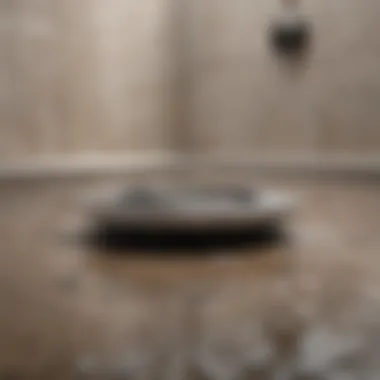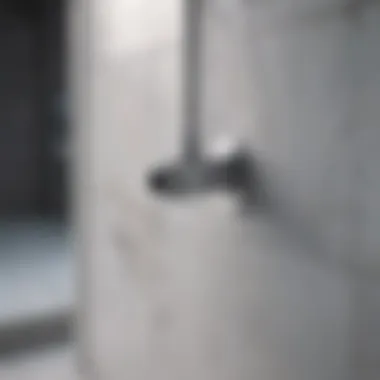Understanding Water Accumulation in Shower Drains


Intro
Water accumulation in shower drains is a prevalent issue faced by many homeowners. This problem can stem from multiple factors, and understanding them is crucial to ensuring effective drainage. Not only does water pooling create inconvenience, but it can also lead to significant structural damage and health concerns over time. In this article, we will examine the causes and implications of water pooling, alongside maintenance practices and plumbing innovations that can help mitigate these risks.
What Causes Water Accumulation?
Various elements contribute to the accumulation of water in shower drains. Here are a few common causes:
- Clogs: Hair, soap scum, and debris can obstruct drainage, preventing water from flowing freely.
- Poor Drain Design: Inadequate slope or improper installation can hinder drainage efficiency.
- Pipe Misalignment: Shifts in the plumbing system can result in water not draining correctly.
Understanding these causes is the first step in addressing the issue effectively.
Consequences of Water Accumulation
The effects of water pooling in shower drains extend beyond mere annoyance. They can cause:
- Structural Damage: Ongoing water accumulation can lead to mold and mildew, compromising the integrity of the structure.
- Health Risks: Moist environments foster the growth of harmful pathogens, impacting the health of residents.
Proper drainage is essential for maintaining a safe home environment.
Maintenance Practices
To keep shower drains functioning well, regular maintenance is required. Here are some essential practices:
- Regular Cleaning: Remove hair and debris from the drain cover frequently.
- Routine Inspections: Check for signs of leaks or misalignment in pipes.
- Use Hot Water: Flushing drains with hot water can help dissolve soap scum and flush away buildup.
Plumbing Innovations
New technologies in plumbing can also aid in preventing water accumulation. Products like the Oatey Shower Drain and the Kohler Linear Drain are designed for enhanced drainage efficiency. They offer improved flow rates and help minimize pooling issues.
Prologue to Shower Drain Issues
Understanding shower drain issues is essential for maintaining a functional and safe bathroom environment. The shower drain acts as the exit point for water after it flows off the body and through the shower floor. Any failure in this system can lead to water accumulation, which may cause significant problems over time. Addressing these issues early can save homeowners from costly repairs and health hazards.
Furthermore, many people underestimate the importance of a properly functioning shower drain. Regular assessments are necessary not only for functionality but also for hygiene concerns. Accumulated water may lead to mold and bacteria growth, creating an unhealthy living space.
Overview of Shower Drain Functionality
Shower drains are designed to facilitate the swift removal of water from the shower area. Typically, they contain a grate or cover that allows water to pass while blocking larger debris. In an ideal scenario, water flows smoothly through the drain and into the plumbing system.
An essential element of shower drain functionality is the trap, which is a curved section of pipe designed to hold a small amount of water. This water acts as a barrier to sewer gases entering the home. However, if the trap or the drain itself gets blocked or improperly installed, it leads to poor drainage and water pooling.
Understanding the specific design and mechanisms of a shower drain can help troubleshoot basic issues. Ensuring that the drain is clear of debris and properly aligned is essential for optimal function.
Common Problems and Their Implications
There are several common problems associated with shower drains that can lead to water accumulation. These include:
- Blockages: Hair, soap scum, and other debris are common contributors to clogs. If not regularly addressed, these blockages can lead to severe drainage issues.
- Improper installation: If the shower drain is not level or is incorrectly placed, water may not flow appropriately, causing pooling.
- Poor slope: The gradient of the shower floor is crucial. If the slope is not adequate, water will gather in low spots, instead of draining efficiently.
Each of these issues carries implications that extend beyond convenience. Clogged drains can cause water to back up, leading to potential damage in neighboring areas. This situation can affect flooring materials, leading to warping or other forms of degradation. Moreover, stagnation can foster a breeding ground for mold and bacteria, representing a risk to health.


Understanding Water Accumulation
Water accumulation in shower drains is a critical subject for homeowners and design experts alike. This phenomenon not only creates an unpleasant shower experience, but also poses risks to the integrity of your bathroom structure and personal health. Understanding water accumulation is essential to tackle issues that may arise from improper drainage. By recognizing its causes and implications, preventative measures can be effectively implemented, thus preserving both your home's condition and your well-being.
Why Does Water Pool in Shower Drains?
Water pooling in shower drains commonly arises from various issues that can develop over time. The primary reason is often blockages in the drain system, which can prevent water from flowing efficiently. Hair, soap scum, or other debris can create a barrier that hinders water flow. Consequently, this blockage causes the water to collect instead of draining away, leading to standing water.
Additionally, there can be structural concerns. If the shower floor gradient is not designed correctly, it can result in water pooling at specific areas. Water should naturally flow towards the drain, but when the gradient is flawed, pooling becomes inevitable. Therefore, understanding these patterns is vital for effective solutions.
Factors That Influence Drainage Issues
Drainage issues associated with shower drains can be tied to several factors. These include the design and size of the drainage system, the angle of the shower floor, and the variability in water pressure. Understanding these factors can help homeowners identify specific problems and take appropriate actions.
Drain Size and Design
The size and design of a drain greatly impact water flow. A drain that is too small for the volume of water it receives may clog frequently. More often, round and square drains are in use. Round designs promote better flow, while square drains can offer aesthetically pleasing options but may require more frequent maintenance. Choosing the right drain design contributes significantly to effective drainage, making it a critical factor in preventing water accumulation.
Shower Floor Gradient
The gradient of the shower floor is another crucial aspect in understanding water accumulation. An ideal gradient directs water toward the drain, ensuring that it does not pool. Generally, a slope of about one-quarter inch per foot is recommended. If this angle is not maintained, the likelihood of standing water increases. Consequently, proper gradient installation is essential for effective drainage and helps prevent the growth of mold and mildew.
Water Pressure Variations
Water pressure can also affect how water flows and drains. It can impact how quickly the water moves through the pipes. High water pressure can lead to stronger flow, while low pressure might encourage pooling. Occasionally, variable pressure systems can contribute to instability in flow, causing water to linger longer than it should. Being aware of your plumbing system's pressure can help in managing potential drainage issues effectively.
Consequences of Standing Water
Water accumulation in shower drains can lead to significant issues over time. Understanding these consequences is essential for homeowners and anyone responsible for maintenance. Failure to address standing water can result in both immediate and long-term problems. This section examines the impacts of stagnant water on structural integrity and health.
Structural Damage Risks
Impact on Flooring Materials
Prolonged exposure to standing water can severely affect flooring materials. Many common materials, like wood or laminate, are not designed to withstand moisture. When water pools, it can lead to warping or deterioration.
- Key Characteristic: Flooring materials such as tile or vinyl may seem resilient, but their joints and adhesives can fail under sustained moisture.
- Benefit of Knowledge: Recognizing how moisture can damage flooring aids in timely repairs.
- Unique Feature: Moisture-resistant materials are an option for wet areas, but proper installation is critical to prevent gaps that can allow water to infiltrate underneath.
- Advantages: Of course, using durable materials can prolong lifespan; however, it's crucial to maintain these choices to avoid costly repairs.
Long-term Effects on Shower Walls
Water that lingers can also have detrimental effects on shower walls. This is especially true for drywall or materials that aren't waterproof. Over time, moisture can seep into walls, leading to mold growth and structural issues.
- Key Characteristic: Many homeowners opt for tiles on shower walls due to their resistance to water damage.
- Benefit in Design: Understanding these implications can inform better design choices, ultimately leading to more durable installations.
- Unique Feature: Waterproof wall panels are available and can help mitigate damage from standing water. They offer not just aesthetic appeal but functional benefits as well.
- Advantages: Choosing appropriate materials can minimize risks, but regular maintenance remains essential to ensure wall integrity.
Health Hazards Associated with Stagnant Water
Mold Growth Potential
Stagnant water is a perfect environment for mold to thrive. Mold spores are not just a nuisance; they can affect health. Prolonged exposure may cause respiratory issues or allergic reactions.
- Key Characteristic: Mold can grow quickly in warm, damp environments, making bathrooms particularly vulnerable.
- Vital Information: Mandatory awareness and action against mold growth is essential for maintaining a safe environment.
- Unique Feature: Some materials resist mold growth better than others, such as glass tiles or certain types of treated drywalls.
- Advantages: Using such materials can reduce the likelihood of mold formation, but they should still be regularly inspected to prevent problems.
Bacterial Proliferation Effects


The presence of stagnant water not only supports mold but also fosters bacterial growth. These bacteria can lead to further health complications, such as skin infections and gastrointestinal issues.
- Key Characteristic: Certain bacteria thrive in moist, untreated environments, making it crucial to manage bathroom hygiene.
- Importance: Understanding these risks assists homeowners in deciding how to approach hygiene and maintenance efforts.
- Unique Feature: Many cleaning products are designed to eliminate harmful bacteria, but prevention is always better than cure.
- Advantages: Regular cleaning can significantly minimize this risk, but residents must remain vigilant, especially in high-moisture areas.
Preventive Measures: Best Practices
Preventive measures are crucial when it comes to maintaining shower drains. Implementing systematic practices can safeguard against water accumulation issues, enhancing both the functionality and longevity of plumbing systems. Understanding the aspects of maintenance and innovative designs can offer homeowners greater peace of mind, reducing potential hazards related to stagnant water.
Regular Maintenance Routines
Clearing Debris from Grates
Regularly clearing debris from grates is essential for ensuring proper water flow. Over time, hair, soap scum, and other residues accumulate, blocking water drainage. The key characteristic of this practice lies in its simplicity. No specialized tools or expensive solutions are necessary; it is a straightforward task that homeowners can easily manage on their own.
Benefits of this practice include a significant reduction in drainage problems. When water can flow freely, the risk of standing water is diminished, thus preventing mold growth and structural damage. Also, this routine is popular because it promotes hygiene. A clean drain is less likely to harbor unpleasant odors or harmful bacteria.
However, a potential disadvantage is the time required to perform this task. In busy households, maintenance can be inadvertently neglected. As a result, setting reminders for regular checks can be a helpful strategy.
Periodical Drain Cleaning Solutions
In addition to routine debris clearing, periodic drain cleaning solutions play an important role in maintaining shower drains. This process typically involves the use of professional cleaning agents and equipment that target stubborn buildup that can occur over time, such as grease and mineral deposits.
The key characteristic of these solutions is their efficiency. While simple clearing is beneficial, deeper cleaning ensures that all types of buildup are thoroughly eliminated. This eventually helps in avoiding unexpected plumbing problems in the future. Choosing this option can also save money long-term by preventing significant repairs.
However, there are some considerations. Not all cleaning agents are eco-friendly, so it is important to choose products that won’t negatively impact the environment. Balance is key when selecting a cleaner that is both effective and safe.
Innovative Drain Designs
Trench and Linear Drains
Trench and linear drains represent a modern advancement in shower drainage that addresses many of the concerns associated with traditional drains. These designs feature elongated channels, allowing for efficient water removal while also offering aesthetic versatility. The main characteristic of trench drains is their ability to accommodate larger volumes of water without clogging.
This design is beneficial as it helps to prevent standing water, even during heavy usage. Homeowners appreciate that these drains can often be integrated into various design styles, offering both functionality and visual appeal. Moreover, the low maintenance required can make trench drains an attractive option for many.
On the downside, installation can be more complex and costly compared to standard drains. Homeowners must consider whether the initial investment aligns with their budget and needs.
Self-Cleaning Drain Technology
Self-cleaning drain technology represents a forward-thinking solution designed to minimize maintenance needs. Using advanced systems, these drains utilize water jets or other mechanisms to prevent buildup automatically. Their key characteristic lies in their capability to address blockages as they emerge.
The significance of self-cleaning technology is its potential to reduce the frequency of manual cleanings. This also translates to increased hygiene within the drainage system, as constant cleaning minimizes residues that often generate odors and attract pests.
However, while the convenience is undeniable, the technology can be expensive. It may not fit into every homeowner's budget. Therefore, understanding long-term benefits versus initial costs is essential when considering this option.
By recognizing the importance of preventive measures, homeowners can significantly reduce the risk of water accumulation issues in shower drains. [Source: en.wikipedia.org]
Repairing Existing Drain Issues
Repairing existing drain issues is critical for maintaining functional and clean shower spaces. When drains fail, it can lead to more than just inconvenient standing water; it can also precipitate significant structural damage to the surrounding area. As we explore this topic, we will focus on identifying common blockages and knowing when to seek professional help.
Identifying Blockages and Their Causes
Dealing with blockages is the first step in addressing drainage issues. Two predominant culprits often contribute to this problem: hair and soap build-up and grease and mineral deposits.


Hair and Soap Build-up
Hair and soap build-up form a significant obstruction in shower drains. This accumulation happens gradually, often unnoticed at first. Hair intertwines with soap residue, creating a dense mass that inhibits water flow. One key characteristic of this type of blockage is its commonality in both residential and commercial showers. It is a growing concern as it becomes a recurring problem for many homeowners. Addressing this issue as soon as it appears can prolong the life of the drain system.
In addition, hair and soap build-up can produce foul odors due to decomposition. This makes it not only physically bothersome but also an unsanitary environment. Regular cleanings and preventative measures—such as drain screens—can help deter this buildup effectively.
Grease and Mineral Deposits
Grease and mineral deposits represent another common source of shower drain blockage. These deposits are often the byproduct of soap, shampoos, and conditioners, which contain fats and oils. Over time, they solidify on the inner walls of the drain, narrowing the passage and creating stagnant water pools. The key characteristic of grease and mineral deposits is their sticky nature. This aspect allows for easy accumulation of additional materials, compounding the problem.
Grease is also problematic because it can attract other debris. When combined with hair and soap, it can quickly lead to severe clogging, making it a challenging issue to resolve. Regular cleaning with appropriate chemicals or hot water can assist in mitigating the buildup, helping to maintain better drainage.
When to Call a Professional
At times, identifying and dealing with blockages may exceed the capabilities of a typical homeowner. Understanding when it is time to call a professional plumber can save time and prevent further damage. Here are indicators to consider:
- Chronic Blockages: If you find yourself dealing with frequent clogs despite regular maintenance, professional intervention may be necessary.
- Unusual Noises: Gurgling sounds from the drain could indicate deeper issues in the plumbing system.
- Visible Damage: Cracks around the drain or visible leaking should prompt immediate assessment by a professional.
Addressing existing drain issues promptly not only improves shower functionality but also protects the broader structure of the bathroom from potential water damage.
"Ignoring drainage problems can lead to extensive and expensive repairs down the line."
By keeping these factors in mind, homeowners can better understand their shower drain systems and make informed decisions on repair and maintenance.
Future Trends in Plumbing Solutions
Understanding the future trends in plumbing solutions is crucial for addressing the persistent issues of water accumulation in shower drains. As technology evolves, so too does the approach to efficient water management. Adopting modern plumbing solutions not only minimizes the risk of standing water but also enhances overall system durability and efficiency. Embracing these advancements can lead to significant benefits, including water conservation, improved health outcomes, and lower maintenance costs.
Smart Plumbing Technologies
Water Monitoring Systems
Water monitoring systems represent a significant advancement in plumbing technology. Their main function is to detect leaks or blockages in real-time, providing essential data to homeowners about their plumbing system. A key characteristic of these systems is their ability to alert users via smartphone notifications. This feature is beneficial because it allows for immediate action to be taken, potentially preventing significant water damage.
These systems often come equipped with unique features such as flow rate monitors and pressure sensors. These characteristics offer a comprehensive view of plumbing health and can identify issues before they escalate. However, while beneficial, initial installation costs can be high relative to traditional systems.
Integration with Home Automation
The integration of plumbing systems with home automation is another banner trend in plumbing. This technology enables users to control their plumbing through smart home systems. Typical features include programmable schedules for showers, automatic monitoring of water usage, and alerts for maintenance needs. This integration makes it a popular choice for modern homes looking to simplify water management.
A unique aspect of home automation integration is the ability to create a cohesive management system that not only covers plumbing but also ties into lighting, heating, and other home automation units. Although convenience is a significant advantage, potential drawbacks include reliance on stable internet connectivity and sometimes complex installation procedures.
Sustainable Practices in Shower Design
As environmental concerns become more pressing, sustainable practices in shower design are gaining recognition. These practices look to minimize water waste and lower the ecological footprint of plumbing systems. Implementing sustainable methods not only aids conservation but also aligns with broader trends in environmental awareness and responsibility in home design.
Water Conservation Techniques
Water conservation techniques focus on reducing water usage without sacrificing comfort. These methods include low-flow showerheads or dual-flush toilets designed to use less water. A critical feature of water conservation techniques is their efficiency, making them a valuable choice for homeowners. They not only contribute to lowering monthly water bills but also help in protecting local water resources.
While the upfront investment in some devices may be higher, they often pay off in the long run through reduced water costs and fewer environmental impacts. However, users must ensure that the chosen products meet their expectations in performance and comfort.
Eco-friendly Drainage Solutions
Eco-friendly drainage solutions aim to minimize the negative impacts of plumbing systems on the environment. These solutions often employ materials that are sustainable, such as recycled plastics or biodegradable options. A key characteristic of eco-friendly drainage is their reduced environmental impact.
Many of these systems are designed to manage rainwater naturally, which can reduce runoff and protect surrounding ecosystems. However, they may require more maintenance than traditional systems, which could be seen as a disadvantage depending on the user's lifestyle.
These emerging trends in plumbing not only address the problem of water accumulation in shower drains but also pave the way for more efficient and eco-conscious home designs. By understanding these innovations, homeowners can better inform their choices for long-term benefits.







